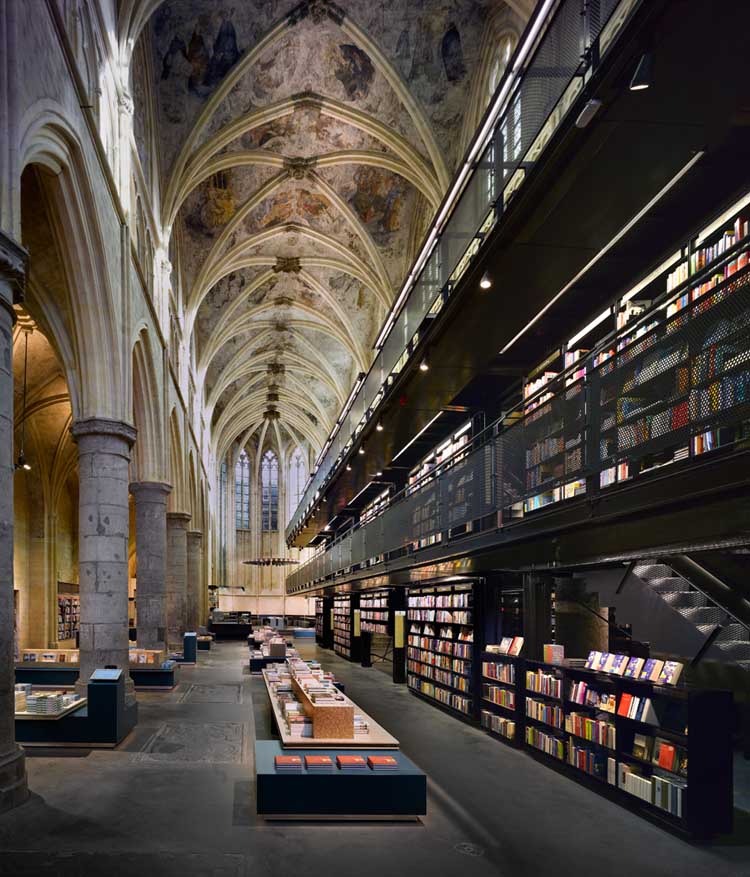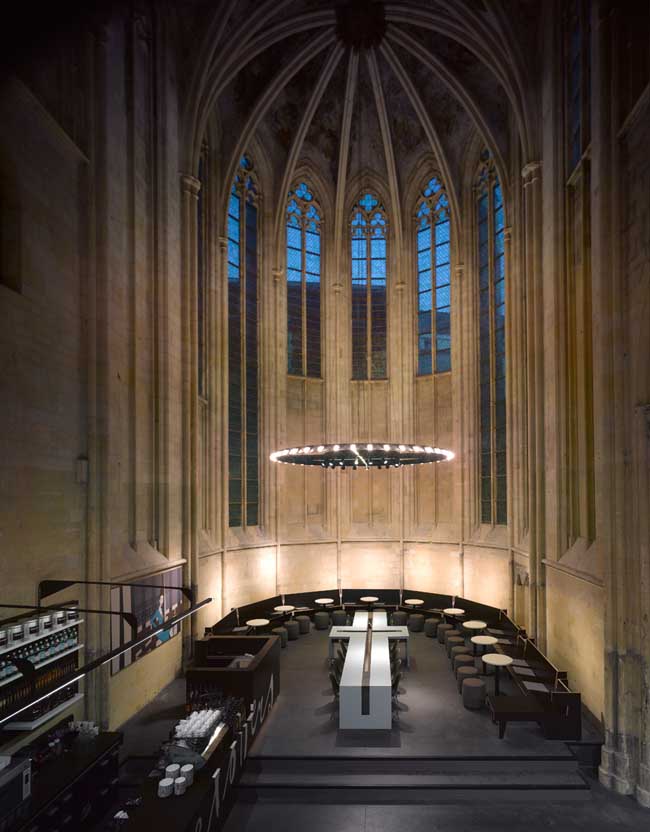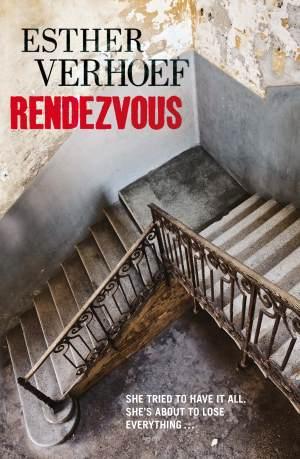
I don’t say this lightly, and I am well aware that everyone has his or her favorite, but I will not accept any arguments this time. Even The Guardian backs me up—for sheer gorgeousness, Selexyz Dominicanen in Maastricht wins. (For the record, I first visited it two years ago, before I’d read the Guardian piece, and I’m taking full credit for introducing it here.)
Originally a Dominican church with a history that dates back to the 13th century, it now houses three levels of stacks under its vaulted, frescoed ceilings. Climb to the top level and you have a Michelangelo-quality view of the 14th-century frescoes. Wander into the apse and you can buy a cup of coffee, park yourself at the cross-shaped common table and soak in the atmosphere, which at 1:30 p.m. on a sunny Wednesday was filled with buyers and browsers of all ages and literary persuasions.

Two middle-aged men met up to eat lunch. Three teenage girls sat huddled together making fun of photos in fashion magazines. Solo women of indeterminate age (like myself, I choose to believe) sipped their coffee and read. Last time I was here, I wound up in lengthy conversation with a retired Dutchman (did I mention Maastricht is in the Netherlands?) asking me to explain American politics to him. I was unsuccessful. This time I was happy to sip my cafe latte and daydream. I went to Maastricht to attend TEFAF, The European Fine Art Fair, a treat and a privilege. Visiting Selexyz Dominicanen was the cherry on the sundae.
After a sleepless night in Economy Class on KLM, I was experiencing that feeling one has upon arriving on another continent in another time zone—light-headed and eager, as if I’d just invented the world. Somewhere over the Atlantic, when the guy in front of me reclined his seat into my face, I promised myself that my first stop in Maastricht—after a shower and the briefest of naps—would be for coffee at Selexyz Dominicanen.
Naturally, I also was on the lookout for crime.
The section of the store marked “Spanning” (Dutch for “tension”) holds crime novels and thrillers. It’s populated by Charles den Tex, Wouter van Mastricht, and Bram Dehouck, as well as female crime writers including Saskia Noort, Esther Verhoef, Loes den Hollander, Suzanne Vermeer, Marion Pauw and Simone van der Vlugt.
Happily, I report that the Dutch crime genre is alive and well—as you’d expect from the nation that gave us the definitively creepy film The Vanishing (see the Dutch original, not the lame U.S. remake) based on The Golden Egg by Tim Krabbé; and the Oscar-winning Character, from the 1938 novel by Ferdinand Bordewijk. The coveted Gouden Strop (Golden Noose) award for Dutch crime fiction, presented each year since 1986, cultivates and celebrates the Dutch crime novel. The winner receives a nifty trophy and a €10,000 prize.
Alas, the Dutch crime novel translated into English needs a bit of a boost. The store’s “English Crime” section is filled with the usual suspects—John Grisham, David Baldacci, Tess Gerritsen, Harlan Coben, Elizabeth George, James Patterson—and, oddly, almost an entire shelf dedicated to Haruki Murakami. The entire selection of Dutch novels translated into English spanned a mere half shelf.
Crushing.
Of course the Dutch clientele would read their Dutch novels in Dutch. If they wanted to read in English, they would read books by writers who write in English and James Patterson. Yet for readers like me, the English-language choices were limited to what I could find at home—and, if we’re being honest, find at home cheaper. What I wanted was something Dutch.
Travel whets your appetite for local culture, and nothing reveals a culture quite as well as a book written by a local author for a local audience. That’s why I discovered Archer Mayor when I vacationed in Vermont and why every gift shop in Santa Fe has a shelf full of Tony Hillerman books. So why would I schlep John Grisham with me through the Netherlands when I could bring three-time Golden Noose winner Charles den Tex or 2010 winner Bram Dehouck along for the ride?

Now I’m on the hunt for Simone van der Vlugt’s Shadow Sister, which came out in English this year, and for Saskia Noort’s The Dinner Club. I might pick up one of A.C. Baantjer’s Inspector DeKok mysteries as well. And I’ll try to unearth (she said optimistically) the copies of The Corpse on the Dike and Mind Murders, 1970s-vintage police procedurals by Janwillem van de Wetering that I bought at a library book sale and read years ago.
It’s almost June, better known as Maand van het Spannende Boek (Crime Fiction Month) in the Netherlands. I want to be prepared.
Leslie Gilbert Elman blogs intermittently at My Life in Laundry. She’s written two trivia books and has a few unpublished fiction manuscripts in the closet to keep the skeletons company.

Wow, that does look impressive. Maastricht is on the other side of the Netherlands for me, but I’ll be sure to pay a visit to the Selexyz if I’m ever in the neighbourhood!
As a fan of Golden Age detective novels, I practically never read Dutch crime fiction, as modern thrillers are way more popular here. I do like the old Judge Dee (Robert van Gulik) series, historical detectives set in ancient China. Van Gulik, a scholar in Sinology, wrote clever detectives, which were really detailed in their description of ancient China.
Lucky for you, the Dutch trains are speedy and comfortable! I love that I landed at Schiphol Airport and boarded a train right there that took me to Maastricht (via Utrecht). Trains to and from the airport…what a concept.
I read one Judge Dee novel years ago and it didn’t captivate me, but I think I need to try another. Really, I was just pleased to see how much Dutch crime fiction there is.
What a gorgeous setting for a library. I’m not sure that I could actually read there. It seems more a place for meditation.
If there’s any city in which I could imagine a good bookstore inhabiting a vaulted and frescoed medieval church, it would be Maastricht. It’s a charming place. I’ll check out Selexyz Dominicanen next time I’m there.
This gorgeous, friendly store is in danger of closing! Selexyz filed for bankruptcy in 2012. The store is now operated by Polare and is running a crowdfunding campaign to stay in business.
[url=https://www.crowdaboutnow.nl/Dominicanen]https://www.crowdaboutnow.nl/Dominicanen[/url]
I just checked the link you provided, Leslie (thanks!) and currently the campaign is funded at 200%, so hopefully we’ll all have a chance to visit this gem–I’d love to see it myself!
Thnaks for Shaering it